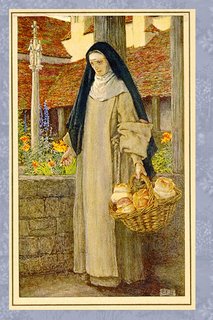
Life in the medieval ages for a woman was very difficult indeed, even such things as catching cold could prove fatal as antibiotics had not yet been discovered and every woman both Noble and peasant faced death with the birth of each baby. Many families relied on herbs or insects as their only source of medications, including leeches.
Most families ate whatever was available in their area and nothing of an animal was wasted, they ate every part of the animal that was digestible and that which wasn't was used in broths. Those who worked for the Nobility and lived in fortified castles were able to prepare and pickle certain meats, fruits and vegetables. Meat could also be pounded down to a paste format and with mixed herbs was served as a sauce or 'custard'.
There were very few places where a woman could earn her own way or become independent, in some cases women would often join Convents or nunneries so as to live with some degree of autonomy usually these ladies were those who could pay the dowry needed. There were many though who felt God calling them to this vocation and so many entered the Convent life and obeyed their particular Rule. The main Vows taken were poverty, chastity and obedience.
This didn't make things any easier for the women, in that work still had to be done and food still had to be prepared for their Religious community, as well as living a life of intense prayer and worship.
One of the first Orders began was the Benedictine and many who chose to live as Religious lived this particular Rule, which had been established approximately 529 AD. Other Orders were established at a later date including The Franciscans, Carmelites, The Ursulines and some others.
In the medieval Convents where you were placed and what job you did depended on one's social stature in the outside world. Those women who were from the Nobility did not do the heavy work required of a Nun who was less monetarily well off.
Depending on the Abess whether she was an authoritarian figure or less inclined to impose the Rule, but many Nuns during this particular Era also practiced severe mortifications and penances, some even wore a hair shirt, and deprived themselves of food for long periods of time.
It wasn't until later that more discipline would be introduced to some of the Religious Orders, but even so every Nun had their job to do whether it be embroidery, sewing, cooking, cleaning, laundry and tending the garden. Each Nun also had to comply with the spiritual requirements of prayer, study, Mass and serving their community. The order of these rituals were as follows;
3 am.........Matins
5 am..........Lauds
6 am.........Prime
9 am.........Terce
Noon......Sext
3 pm.......Nones
6 pm.......Vespers
8 pm....Compline
Upon Compline the Nuns were expected to go to bed and gain rest for their bodies in order to continue the same time table the next day. The only Nuns who were exempt from following this strict observance were those who were in ill health.
The positions of the Religious are as follows;
Abbess - the head of an abbey who was elected by the nuns for life.
Almoner - an almoner was a nun who dispensed alms to the poor and sick
Cellarer - the cellarer was the nun who supervised the general provisioning of the monastery
Infirmarian - the nun in charge of the infirmary
Sacrist - the sacrist was the nun responsible for the safekeeping of books, vestments and vessels, and for the maintenance of the convent's buildings
Prioress - in an abbey the deputy of the abbess or the superior of a priory that did not have the status of an abbey
At the heart though of every Religious Community was their intense love of God and prayer and their shared communal life with their fellow Sisters.
Things would change when new Religious figures gained prominence and a return to a more structured and disciplined way of Religious life would be embraced, but not without a struggle.
Peace of Christ to you ALL
Copyright © 2006 Marie Smith. All rights reserved.
No comments:
Post a Comment